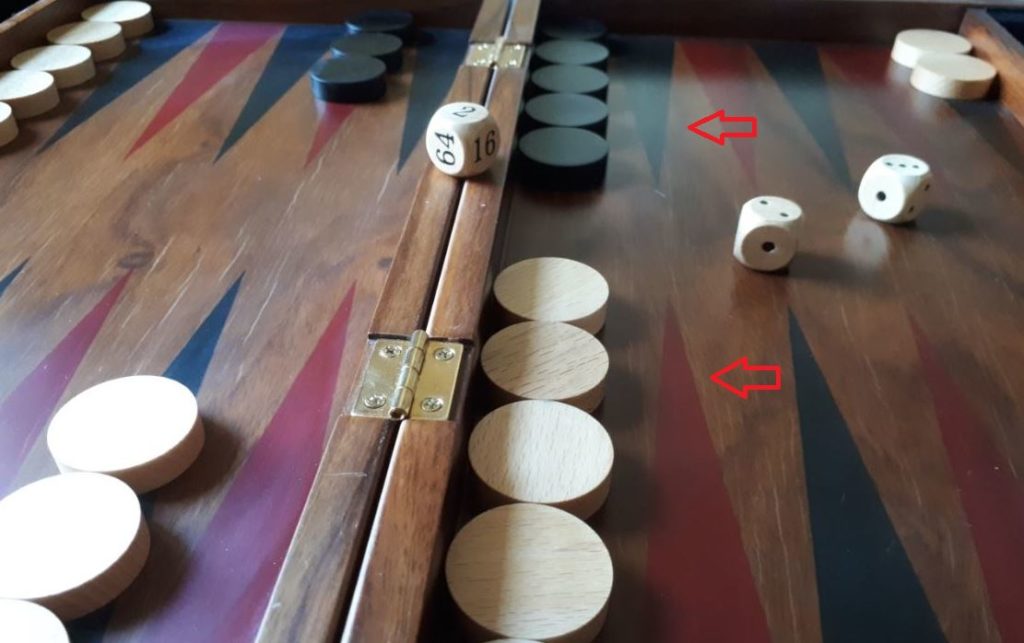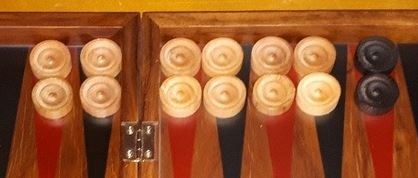Last updated on June 20, 2024
As a general rule of thumb, on each move, you should be looking to secure points, hit blots or move builders. In this Deluxe Backgammon post for beginners, we will focus on the considerations when hitting your opponent’s checkers. Typically, hitting is nearly always the correct option. However, in some circumstances, there may be better options. So the question is, in backgammon
If you have the opportunity to hit on your opponent’s side of the board, it’s usually always the correct choice. It gains a lot of ground in the race and advances your back checkers. In addition, it lands your opponent on the bar, where these may stay for several turns. Even when they manage to re-enter, it takes away at least one of your opponent’s dice rolls for the turn. It is rarely the wrong choice to hit on your opponent’s side of the board. The only exception might be to secure your 20-point, which gives you an advanced anchor in your opponent’s home board.
Choosing to hit on your own side of the board requires a little more consideration. Hitting one of your opponent’s back checkers gains very little in terms of the race. There are strategic considerations that need to be taken before deciding to hit.
Is the opponent’s checker on a key point?
The key points are the 5-point, the 4-point, and the bar-point. You will want to prevent your opponent from securing any of these points. If they secure one of these points, they get an anchor in your home board and restrict your chances of building an effective prime. If you can secure the points, you can start building an effective barricade to lock in their back checkers.
Are you unstacking an overloaded point when you hit?
Hitting and unstacking an overloaded point is a good play. It not only sends your opponent to the bar, but it also helps create a greater distribution of your own checkers, which helps create flexibility. Breaking an already secure point is a weaker play. It breaks down a barrier and creates greater chances of retaliation by leaving blots.
Have you secured an anchor?
If you have an anchor in your opponent’s home board, hitting is almost certainly the right choice. The anchor provides a safe point of re-entry and also helps prevent your opponent from building an effective prime.
Can you secure a key point?
If you have the choice between hitting a checker or securing a key point in your home board, the latter option is often the best choice. Hitting in your own home board gains little in terms of the race and securing a key point will have strategic benefits in subsequent turns. However, hitting from a big stack is even more likely to be correct as this creates more opportunities on subsequent turns with greater flexibility.
How strong is your home board?
A strong home board allows you to play more aggressively and it will be more difficult for your opponent to re-enter from the bar. If they fail to re-enter it gives you time to strengthen your own positions. Even when they do successfully re-enter, they have used up one of their dice rolls.
What is the likelihood of retaliation?
If hitting your opponent’s checker leaves you with a string of blots around the board take into account the chances of retaliation. Checkers that are in the range of a direct hit (6 or less) are extremely vulnerable to retaliation. Blots in the range of indirect hits are far less likely to be attacked.
Are there any other alternatives?
It is all too easy to make the first play that comes to mind. As stated earlier, hitting is generally a good idea. However, before committing to the play take stock of your positions and strategically consider all other moves. In some circumstances, there may be a better option than hitting.
In the example below, white opened with a 4-3. They split the back checkers and moved 24/21 hoping to secure an advanced anchor on a subsequent move. Then they moved a builder down from the mid-point by moving 13/9. Black rolls a 3-1 on their turn. Clearly, this gives black an option to hit the white checker on their 4-point. However, black doesn’t gain much from this hit as there is very little impact on the race. In addition, black could get hit on re-entry, which would send them well behind in the race. The best move here for black is 8/5, 6/5 which secures the 5-point, unstacks the 6-point and starts to build a prime.

Related content
Rules of thumb. Overall, these rules will help to simplify your decision-making process.
Making a hit from howstuffworks.



I’m an aggressive backgammon player and typically play the blitz strategy. For me, I hit at every opportunity, its a fun way to play backgammon.